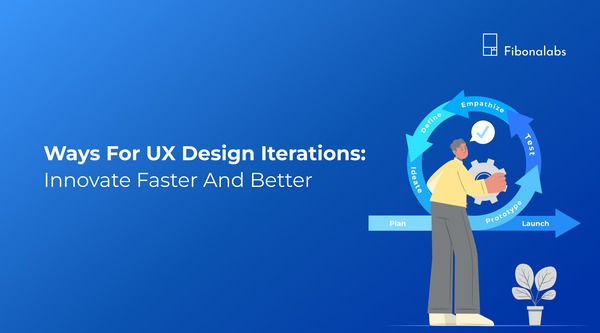Customer Journey Mapping: Efficient Tool for User-Centric Design
In an era where the user experience of the product or service is a deal-maker for a successful business and designers are focusing on creating user-centred experiences. This has led to an increased emphasis on the design process, and the design community has resorted to using various tools and techniques to make our process user-centred.
Design is a process that equips business and design teams with a deep understanding of their users so that they can ideate, prototype, and test user-centred solutions. This article illustrates the usage of one such tool that enables design: This is called customer journey mapping.
What is a Customer Journey Map?
A customer journey map is a tool that combines the power of storytelling and visualization to help teams understand the physical & psychological process a user goes through to accomplish a certain goal. Though journey maps can be customized based on the business objective, stage of the design process, and context, there are a few key elements and guidelines that can help you to get the best of a customer journey map.

Elements of a Customer Journey Map
- Actor
The actor is the persona or a user who experiences the journey. It is a point of view for the whole journey map. Actors usually align with personas, and their actions on the map are rooted in data.
Tips: Create a Persona before journey mapping. In the persona, include behaviour, attitude, and psychometric details of the user; this will help in defining the journey based on the characteristics of the persona.
- Scenario + Expectations
A journey map is associated with a situation in focus, where the user/persona is looking to accomplish a goal. A scenario is the description of a situation. The expectation is the goal or needs to try & achieve the goal. The scenario can be real or anticipated (if the solution is yet to be created).
Tips: Keep the characteristics of the persona plotted while creating the scenario & expectations. The scenario can be created for multiple personas as well.
- Journey Phases
This element provides a high-level understanding of the journey. While accomplishing the goal, the journey phase should be created based on a series of events that the user/persona is exposed to.
- Actions, Mindsets, and Emotions
These are behaviours, thoughts, and feelings the actor has throughout the journey. These are mapped within each of the journey phases.
Actions are a narrative of the steps taken by the user in the given phase of the journey. This reflects what the user does on the stage.
Mindsets correspond to users’ thoughts, questions, motivations, and information needs at different stages in the journey.
Emotions depict the user’s feelings through the journey. This is usually a graphical representation to illustrate the user’s emotional state.
Tip: Refer to the persona & scenario to understand how a user would behave in the specific phase of the journey.
- Opportunities
This is the part where the team can plot down the insights gained from the activity of journey mapping.
- What needs to be done with this knowledge?
- Who owns what change?
- Where are the biggest opportunities?
- How are we going to measure the improvements we implement?
This makes it important to choose the right type of journey map before going ahead.

Types of Customer Journey Map
A customer journey map can be produced in different forms, and choosing the type would be the first step in creating one. These are a few types and guides on how to choose one that fits your requirement:
- Based on the Context:
- Current State: It is used to visualize an existing experience of the user. It provides the team with an idea of how the product/service is being used currently. When to use: To identify and document existing problems for the user, and formulate solutions to the problem.
- Future State: It is used to visualize the ideal case scenario of how the design is intended to use by the user. It gives the team an idea of the expected result from the design process. When to use: To re-invent the journey of the user towards producing a better experience.
- Based on Available Data:
- Hypothesis First Approach: This approach used the existing data to make assumptions about the user’s journey, and it is used for educating teams on the problem at hand and gaining team buy-in. When to use: This is effective for co-creation with the business and drives the team towards a focused mindset.
- Research First Approach: This approach involves conducting primary research and then creating the journey based on the data collected. This approach is lengthy, expensive, and misses out on collaboration. When to use: In a research-let project where primary data is collected, and when the team is yet to have an idea of the user’s behaviour/ process.
What is there after Customer Journey Mapping?
- Service Blueprint: A customer journey map focuses on the user as the actor and presents opportunities for the service to fit in and help the user to accomplish the goal in a better way. The journey map forms the front-stage action of the service blueprint, and the backstage operations can be incorporated. This could be a better way of designing a service.
- Defining KPI: As the journey map defines the expectations of the user, it helps the team identify and set the key performance indicators for each stage. These KPIs can be later used for validating the design with the user. This also makes sure that the team is focused on the KPIs.
- Making User flows: Each stage of the journey had the user’s actions, mindset, and emotions described. This forms the base of creating a user flow, which can be translated into a digital design. The user flows resulting from the journey map are more valuable as they tag with the emotions and experiences of the user.

Customer journey mapping is a very efficient tool to ensure that the design is user-focused and also for documenting the process. It helps the team in moving towards a common objective and provides a rationale for the design outputs. When used in the right way, it can reveal opportunities for improvement and can enrich the user experience. Finally, as journey mapping is a tool to enable design, it should not be a deliverable but a start towards user-focused design.



